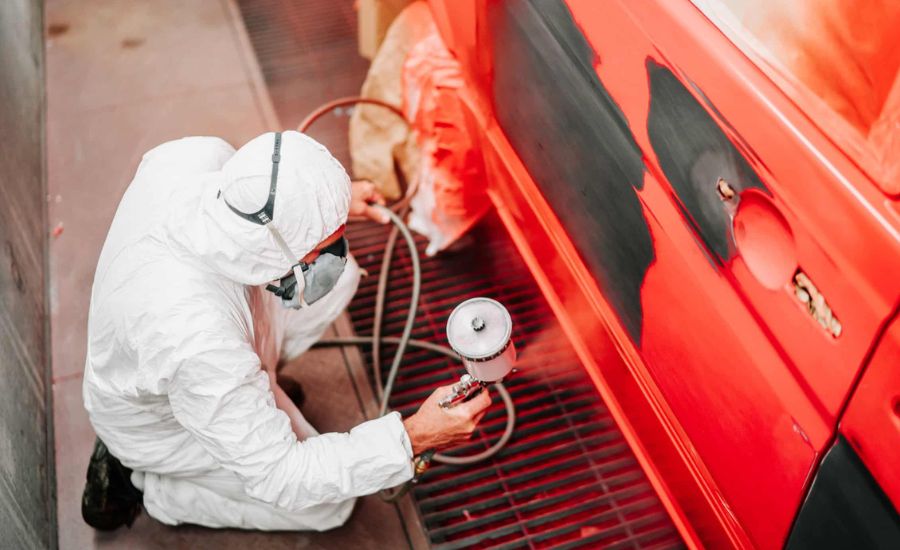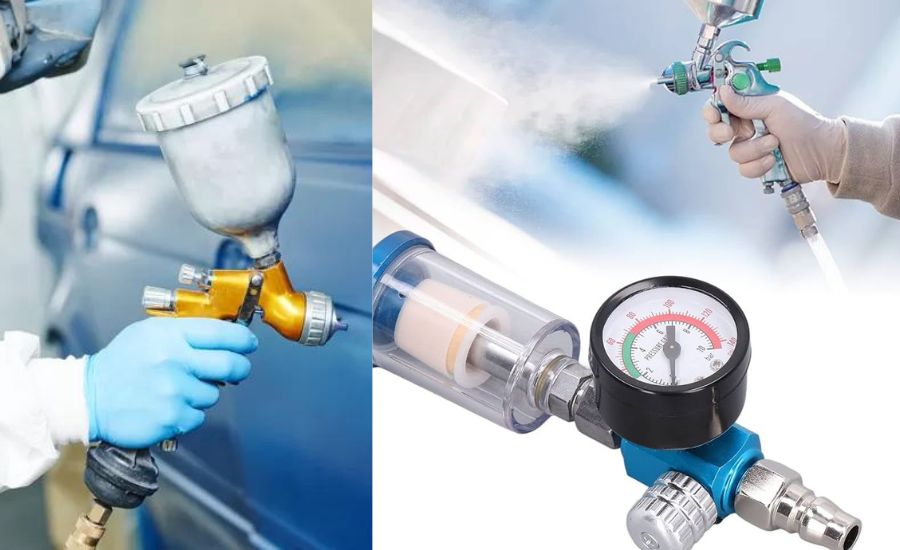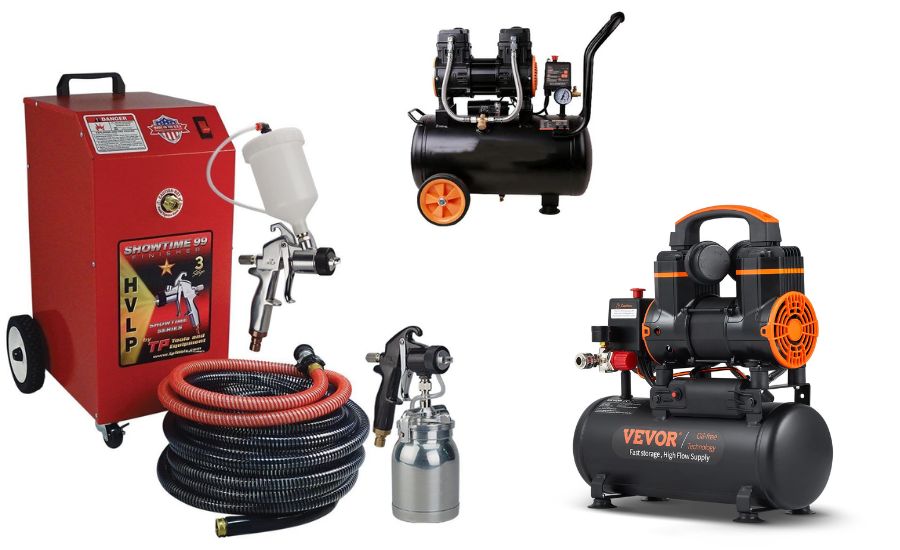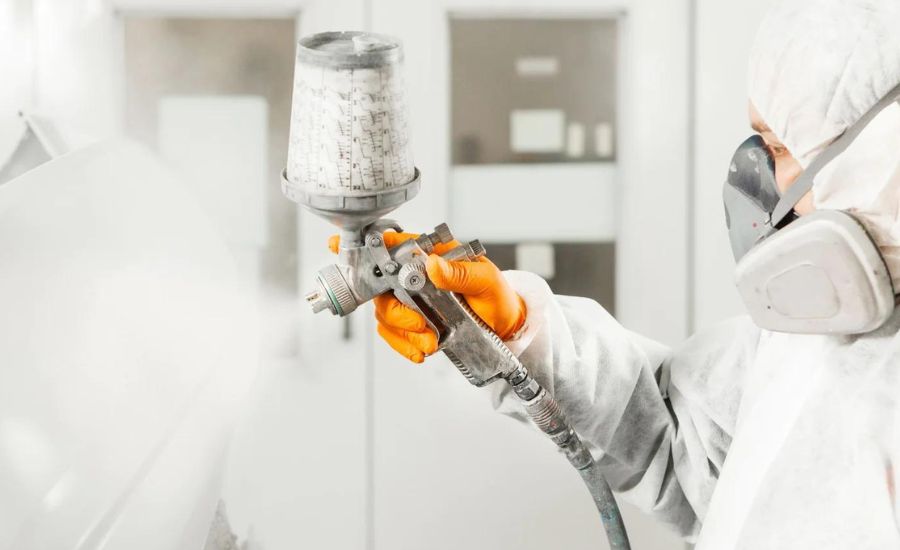How big of a compressor do I need to paint a car successfully? Selecting the best air compressor of the correct size is a critical aspect of achieving a flawless auto-painting job.

The basics of air compressor sizing
Knowing what size air compressor you require is essential for ensuring optimal air pressure and volume, pivotal factors that directly impact the quality and precision of car painting projects.
Air pressure you need to paint a car
Air pressure rating plays a pivotal role in the painting process as it determines the force with which car paint is delivered onto the car’s surface.
Proper pressure is crucial for atomizing the paint — breaking it down into fine particles — allowing for an even and smooth application.
This atomization ensures the paint adheres well to the surface and results in a professional finish.
PSI refers to the pressure level at which the air is delivered from the air compressor to the spray gun. The recommended PSI for spray painting typically falls within the range of 25 to 50 PSI.
However, the exact PSI requirement can vary based on different factors.
Type of paint you need to paint a car: different paints (e.g., metallic, base coat, clear coat) might require specific PSI levels for optimal atomization and application. Metallic paints or thicker coats often demand higher PSI to break up the particles effectively.
Spray gun specifications: various air tools have different PSI recommendations. HVLP (High Volume Low Pressure) guns, for instance, generally operate at lower PSI compared to conventional spray guns.
Desired finish and detail work: the PSI setting can also depend on the desired finish and the intricacy of the job.
Finer detail work may require lower PSI settings for precision, while larger surface areas might benefit from higher PSI levels to ensure even coverage.

CFM rating you need to paint cars
CFM rating stands for Cubic Feet per Minute and is a unit of measurement used to quantify the volume of air that an air compressor for painting can deliver. It indicates how much air the air compressor can push out in a minute and is a crucial factor in determining the capacity of an air compressor you need to paint a car.
The CFM requirement for painting a car depends on several factors, including the type of spray gun being used and the size of the nozzle.
Calculating the necessary CFM rating involves considering the air volume necessary to atomize the paint and achieve a smooth, consistent finish.
Paint gun specifications: different air tools have varying CFM requirements. Checking the manufacturer’s specifications or documentation accompanying the spray gun is crucial to ascertain the CFM needed.
Nozzle size and application: the size of the nozzle also impacts CFM requirements. Larger nozzles typically demand a higher CFM rating to properly atomize and deliver the paint, especially for thicker paints or when covering larger surface areas.
Calculation method: while specific formulas exist to calculate CFM requirements based on factors like nozzle size, gun type, and air pressure, manufacturers often provide recommended CFM values for a spray gun. These recommendations serve as a guide to ensure sufficient volume for the paint job.
Consideration for multi-gun setups: in scenarios where multiple spray guns are used simultaneously, the CFM requirement increases accordingly. It’s essential to factor in the cumulative CFM demands if using multiple guns simultaneously.

Factors influencing air compressor size you need to paint cars
The choice of air compressor size you need to paint cars is significantly influenced by various factors, notably the type of spray gun used, such as the efficient HVLP (High Volume Low Pressure) guns or the versatile conventional spray guns, each with distinct air pressure and volume requirements.
- HVLP spray guns
Operational mechanism: HVLP guns are designed to operate at lower air pressures, typically ranging from 10 to 20 PSI at the air cap. They achieve higher transfer efficiency by delivering a higher volume of air at lower pressure levels.
CFM requirements: HVLP guns generally require higher CFM compared to conventional spray guns. They are designed to deliver a larger volume of paint with less overspray, necessitating a higher volume of air to atomize the paint effectively.
Benefits: HVLP guns are known for their efficiency in paint transfer, making them popular for various automotive painting tasks. They tend to result in reduced overspray and paint waste while providing a smoother finish.
- Conventional/LVLP spray guns
Operational mechanism: conventional spray guns operate at higher air pressures compared to HVLP guns, often ranging from 40 to 60 PSI at the air cap. They atomize paint using higher pressure and lower volume.
CFM requirements: conventional spray guns generally have lower CFM requirements compared to HVLP guns. They use higher pressure to atomize the paint, requiring less air volume to achieve the desired spray pattern.
Application and versatility: conventional spray guns are versatile and can handle various types of coatings, making them suitable for different car painting jobs. However, they might produce more overspray compared to HVLP guns.
Project scale
Surface area and complexity: the size of the project directly influences the air compressor size required for a paint job. Larger surface areas (for example, a few cars) or more intricate designs demand an air compressor with a higher CFM output to ensure consistent and adequate coverage without interruptions.
Continuous operation: for larger projects, such as painting an entire car or multiple vehicles, an air compressor with a higher CFM and larger tank capacity becomes essential. This allows for continuous operation without frequent pauses for the air compressor to catch up or refill the tank.
Efficiency and time: a larger air compressor capable of meeting the CFM demands of a sizable project helps maintain efficiency by reducing the time needed to complete the painting process.
Insufficient CFM can lead to uneven paint application, potentially increasing the overall time required for the project.
Single-stage painting: this method involves applying a single coat of paint that serves as both the color and protective layer. Single-stage painting may have lower CFM demands, especially if a consistent, even application is achievable with a single pass.
Multi-stage painting: multi-stage painting processes, involving base coats, clear coats, and additional layers, often require more precise and consistent paint application. Achieving optimal results in multi-stage painting may demand a higher CFM air compressor to handle the different layers effectively.
Precision and layering: the complexity of multi-stage painting, where layers need meticulous application to achieve the desired finish, might necessitate an air compressor with a higher CFM output and consistent pressure delivery to maintain quality throughout each stage of painting.

Calculating the correct compressor size
Accurately calculating the ideal compressor size involves a consideration of both PSI and CFM requirements, pivotal factors that directly impact the effectiveness and precision while painting cars.
PSI and CFM requirements
Calculating the ideal compressor size involves considering both PSI and CFM requirements. The formula generally used is:
[CFM needed] = (Paint Gun CFM) × (Number of Paint Guns)
This formula helps determine the total CFM required for the intended painting setup, accounting for the CFM needs of each spray gun being used.
Example 1: for a setup using two HVLP paint guns, each requiring 10 CFM, the calculation would be:
[Total CFM needed] = 10 CFM (per gun) × 2 (number of guns) = 20 CFM
Example 2: in a scenario with one HVLP gun requiring 15 CFM and two conventional spray guns requiring 7 CFM each:
[Total CFM needed] = 15 CFM (HVLP) + 7 CFM (conventional) × 2 (number of guns) = 36 CFM
Matching compressor specifications
- Finding the right fit based on calculated requirements
Meeting CFM requirements: after calculating the total CFM needed for the painting setup, it’s vital to choose a compressor that provides equal or greater CFM output than the calculated value.
Balancing PSI and CFM: ensure the compressor’s PSI output aligns with the requirements of the spray gun(s) being used while meeting or exceeding the total CFM demand.
Consideration of additional features: look for air compressors with features like adjustable pressure settings and reliable regulators to accommodate continuous painting sessions without interruptions.
- Air tank size
Continuous air supply: a larger tank size allows the compressor to store more compressed air, ensuring a consistent and steady air supply. This is particularly vital for continuous operation while painting cars, preventing interruptions and ensuring a smooth paint application.
Reduced cycling frequency: a larger compressor tank reduces the frequency at which the compressor cycles on and off, minimizing wear on the motor and providing a more stable airflow.
- Duty cycle
Definition: the duty cycle refers to the duration air compressors can operate within a specific time frame, usually expressed as a percentage (e.g., 50% duty cycle).
Prolonged usage consideration: for prolonged painting sessions, understanding the duty cycle is crucial.
A higher duty cycle indicates that air compressors can operate for longer periods without overheating.
Preventing overheating: air compressors with higher duty cycles are better equipped for extended use without the risk of overheating, ensuring reliability and consistent performance throughout prolonged painting sessions.

Conclusion
Choosing the right compressor size is crucial for achieving superior results and efficiency in automotive painting endeavors.
FAQ
What size air compressor is needed for painting a car?
A minimum of 30 gallons with 4-6 CFM at 90 PSI is recommended.
Can I paint a car with a 30 gallon air compressor?
Yes, but check CFM and PSI requirements for your specific paint gun.
Is 12 CFM enough to paint a car?
Yes, but it depends on the spray gun and project scope.
Is a 20 gallon air compressor big enough to paint with?
Yes, but confirm it meets CFM and PSI needs for your paint gun.
What size air compressor is needed for painting a car?
A minimum of 30 gallons with 4-6 CFM at 90 PSI is recommended.
Can I paint a car with a 30 gallon air compressor?
Yes, but check CFM and PSI requirements for your specific paint gun.
Is 12 CFM enough to paint a car?
Yes, but it depends on the spray gun and project scope.
Is a 20 gallon air compressor big enough to paint with?
Yes, but confirm it meets CFM and PSI needs for your paint gun.
What size air compressor for a car?
Typically, most air compressors of 30 gallons or more with adequate CFM and PSI will do.
Do I need a two stage compressor to paint a car?
Not necessarily; a single-stage portable compressor can work, but two-stage compressors offer better efficiency for larger projects.
Do I need an oil-lubricated pump for a car paint job?
No, it is typically preferred to prevent oil contamination in the compressed air, which could affect the paint quality.

